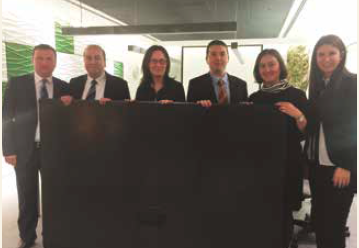Strength of the Two: The Composite Component Bus Project
25 October 2016
İbrahim Eserce
TEMSA Global’s first encounter with composite materials dates back nearly 20 years, when composite (FRP) materials were first used for the interiors of buses and the front and rear panels of vehicles. Over the following 5-8 years, FRP parts in buses were replaced with ABS and polyurethane materials. In terms of competitiveness, the topic of light and durable vehicles is a very crucial topic for all companies in the bus sector. A lighter vehicle means you can lower the fuel consumption, and offer more seats and a higher baggage capacity, thus making your mark on the sector and outstripping your competitors. Innovations and developments in this field resemble a race with no finish line; TEMSA Global has always taken part in this race, aiming to o‑er vehicles that are highly competitive and bring added value to the customer, through both their design as well as new material technologies. As of December 2014, we have followed closely and with great interest the investments of Kordsa Global in the field of composite materials. We met the Kordsa Global Composite Technologies team to discuss the activities, production, objectives and client expectations of our companies. As a result of this mutual sharing of information, we made a decision to create a joint project by bringing together the strategies and objectives of TEMSA Global and Kordsa Global. Our teams prepared a report on our new Marathon vehicle, which we determined as the target vehicle for our project, regarding the possibilities in terms of converting metal to composite by evaluating parts with regard to weight, annual production numbers, costs and alternative production techniques. Composite materials were being used in only a limited number of applications, such as bumpers, protective glass and fenders, and as a result of this report we established an objective to increase the use of composite parts in our vehicles. This was the beginning of “The Composite Component Bus Project”
The vehicle’s “Baggage Lid” became our first project, and there were several reasons behind this choice. Baggage Lid is expected to have high cosmetic performance in terms of surface and visual quality, but at the same time is a moving part that is exposed to dynamic loads. Therefore, baggage lid should be strong and esthetical at the same time. For these reasons, our teams felt that producing a composite baggage lid would be a challenging and exciting target to reach. The objective in our “Baggage Lid” project was reducing the weight of the vehicle while also increasing durability, as well as reducing g the risk of corrosion by replacing metal materials with composite.
Our design teams started by calculating the required endurance values (distortion and deflection solidities) through both computer aided engineering (CAE) as well as tests on the current door design, and we then based our lid design on to these values. At the same time, Kordsa Global developed a custom material for the baggage lid by working on resin and fiber compositions in line with our concept design. Composite materials release a certain amount of gas during use on the vehicle due to the solvent that they incorporate. Since the formula obtained during the selection of resins was solvent-free, the team has enabled the removal of these harmful gasses. As a result, our vehicles have become more environmentally friendly and more sensitive to human health. This has been a very important positive outcome of the project for both Temsa Global and Kordsa Global. Material values were obtained by Kordsa Global through an analysis of the lid prepreg-material lamination, based on the requirements of the baggage lid. Prior to the lid production, these values were validated by the TEMSA Global CAE team in a computer environment using kinematic simulations. Over the course of the project, the CAE design teams gained competence in the analysis of composite materials. The door design entered the final stage with these values.

The prototype production was carried out according to the final door design with the support of a sub-contractor who was based at the firm. The ongoing prototype studies enabled the development of a local supplier who is able to carry out production with prepreg materials. Prototype production was carried out using glass-fiber-based prepreg and glass-carbon-based prepreg. Users of composite materials often face problems caused by irregularities in the resin-fiber ratio of the part concerned. During the production phase of this prototype, the prepreg material was saturated with resin in advance, allowing full control of this aspect of the production process. This development brought TEMSA Global to a point that enabled the company to change its perspective on the use of composite materials.
Through tests (such as paint and adhesive tests) carried out on prepreg sheets and door samples obtained with Kordsa Global, we created material libraries and material testing specifications for future projects. The test stands for the produced baggage lids and road tests on the prototype vehicle continue to take place. In parallel with these tests, preparations for mass production have also commenced. Finally, the crowning glory of our successful project with Kordsa Global was being awarded first place in the Synergy Category of the prestigious Sabancı Golden Collar Awards; we are all extremely proud of our achievements.